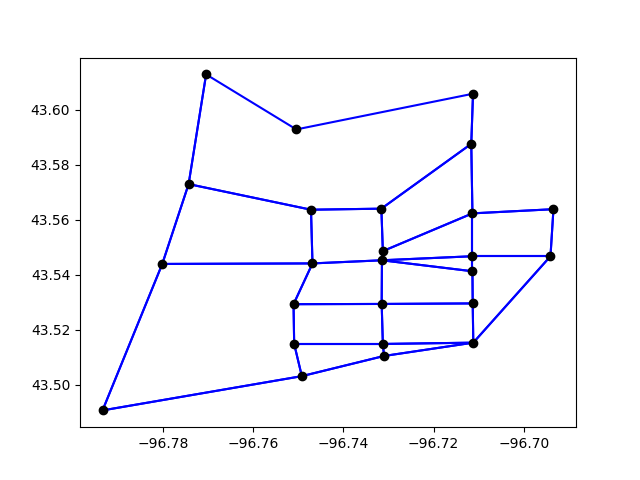Note
Go to the end to download the full example code
Editing network geometry: Links#
In this example, we move a link extremity from one point to another and see what happens to the network.
Imports
from uuid import uuid4
from tempfile import gettempdir
from os.path import join
from aequilibrae.utils.create_example import create_example
from shapely.geometry import LineString, Point
import matplotlib.pyplot as plt
We create the example project inside our temp folder
fldr = join(gettempdir(), uuid4().hex)
project = create_example(fldr)
all_nodes = project.network.nodes
links = project.network.links
# Let's move node one from the upper left corner of the image above, a bit to the left and to the bottom
# We edit the link that goes from node 1 to node 2
link = links.get(1)
node = all_nodes.get(1)
new_extremity = Point(node.geometry.x + 0.02, node.geometry.y - 0.02)
link.geometry = LineString([node.geometry, new_extremity])
# and the link that goes from node 2 to node 1
link = links.get(3)
node2 = all_nodes.get(2)
link.geometry = LineString([new_extremity, node2.geometry])
links.save()
links.refresh()
# Because each link is unidirectional, you can no longer go from node 1 to node 2, obviously
We do NOT recommend this, though…. It is very slow for real networks We plot the entire network
curr = project.conn.cursor()
curr.execute("Select link_id from links;")
for lid in curr.fetchall():
geo = links.get(lid[0]).geometry
plt.plot(*geo.xy, color="blue")
all_nodes = project.network.nodes
curr = project.conn.cursor()
curr.execute("Select node_id from nodes;")
for nid in curr.fetchall():
geo = all_nodes.get(nid[0]).geometry
plt.plot(*geo.xy, "o", color="black")
plt.show()
# Now look at the network and how it used to be

project.close()
Total running time of the script: (0 minutes 0.635 seconds)